

Compact Muon Solenoid
LHC, CERN
| CMS-PAS-HIG-17-009 | ||
| Search for resonant pair production of Higgs bosons decaying to bottom quark-antiquark pairs in proton-proton collisions at 13 TeV | ||
| CMS Collaboration | ||
| November 2017 | ||
| Abstract: A search for a narrow-width resonance decaying into two Higgs bosons, each having a mass of 125 GeV and decaying into a $\mathrm{b\bar{b}}$ pair, is presented. The search is performed using proton-proton collision data corresponding to an integrated luminosity of 35.9 fb$^{-1}$ at $\sqrt{s}= $ 13 TeV recorded by the CMS detector at the LHC. No evidence for a signal is observed and upper limits at a 95% confidence level on the production cross section times branching fraction for such a resonance decaying to two Higgs bosons and each of them to $\mathrm{b\bar{b}}$ are set in the mass range from 260 to 1200 GeV. | ||
|
Links:
CDS record (PDF) ;
inSPIRE record ;
CADI line (restricted) ;
These preliminary results are superseded in this paper, JHEP 08 (2018) 152. The superseded preliminary plots can be found here. |
||
| Figures | |

png pdf |
Figure 1:
The selection efficiency for simulated ${\mathrm {X}\to \mathrm {H}(\mathrm {b} \bar{\mathrm {b}})\mathrm {H}(\mathrm {b}\bar{\mathrm {b}})}$ events (X is a spin-2 Bulk KK-Graviton) at different stages of the event selection for each mass hypothesis, for the low-mass region (solid) and the medium-mass region (dashed). The vertical line at 580 GeV shows corresponds to the transition between twe two selections. |
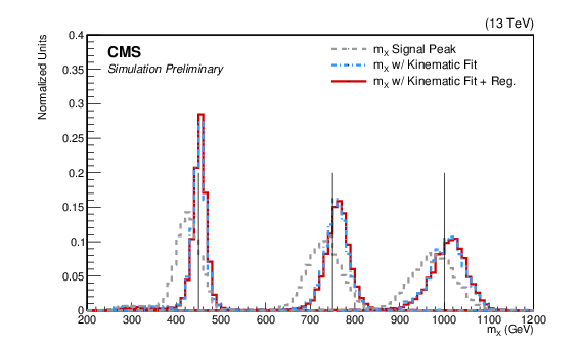
png pdf |
Figure 2:
The $m_X$ distribution of signal simulated events (spin-2 Bulk KK-Graviton) after the event selection criteria for the 450, 750 and 1000 GeV mass hypotheses, with and without the correction by the kinematic constraint to $m_H$ and the specific b-jet energy corrections. |

png pdf |
Figure 3:
Illustration of SR and SB in the ($m_{H1}$, $m_{H2}$) plane used to motivate and validate the parametric model for the QCD multijet background. The quantities $m_{H1}$ and $m_{H2}$ are the two reconstructed Higgs boson masses after b tagging and kinematic selections for data in medium-mass region. |

png pdf |
Figure 4:
The $m_X$ predicted (blue) distribution in data for the low-mass signal region in the lower fit range and the actual distribution in the signal region (black). |
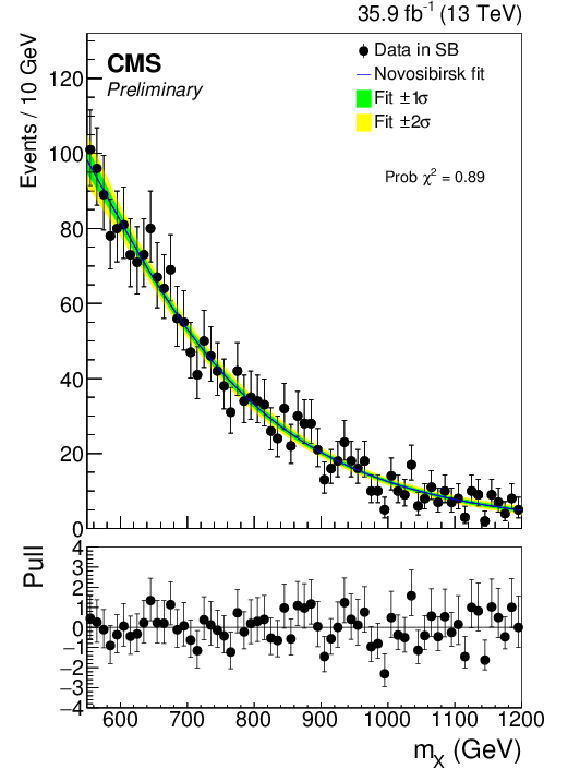
png pdf |
Figure 5:
The m$_X$ distribution in the sideband (SB) of the medium-mass region is presented in data. |

png pdf |
Figure 6:
The $m_X$ distributions after the LMR selections for prediction of the Signal Region. These distributions are fitted in the two sub-ranges with both nominal and alternative model ([250,330] GeV (left) [285,625] GeV (right)). A fit to the background-only hypothesis, which consists of the QCD multijet shape is shown. The shaded regions correspond to a $\pm $1 and 2 $\sigma $ variation of this parametrized form. |

png pdf |
Figure 6-a:
The $m_X$ distributions after the LMR selections for prediction of the Signal Region. These distributions are fitted in the two sub-ranges with both nominal and alternative model ([250,330] GeV). A fit to the background-only hypothesis, which consists of the QCD multijet shape is shown. The shaded regions correspond to a $\pm $1 and 2 $\sigma $ variation of this parametrized form. |
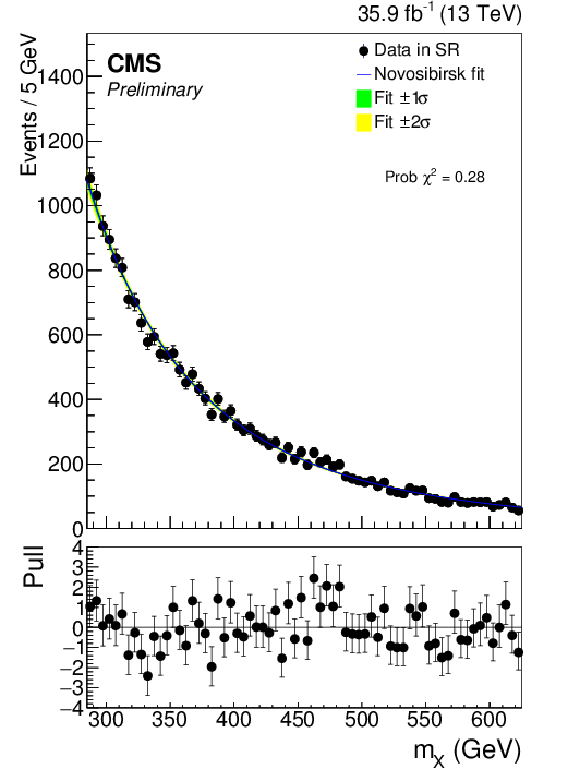
png pdf |
Figure 6-b:
The $m_X$ distributions after the LMR selections for prediction of the Signal Region. These distributions are fitted in the two sub-ranges with both nominal and alternative model ([285,625] GeV). A fit to the background-only hypothesis, which consists of the QCD multijet shape is shown. The shaded regions correspond to a $\pm $1 and 2 $\sigma $ variation of this parametrized form. |
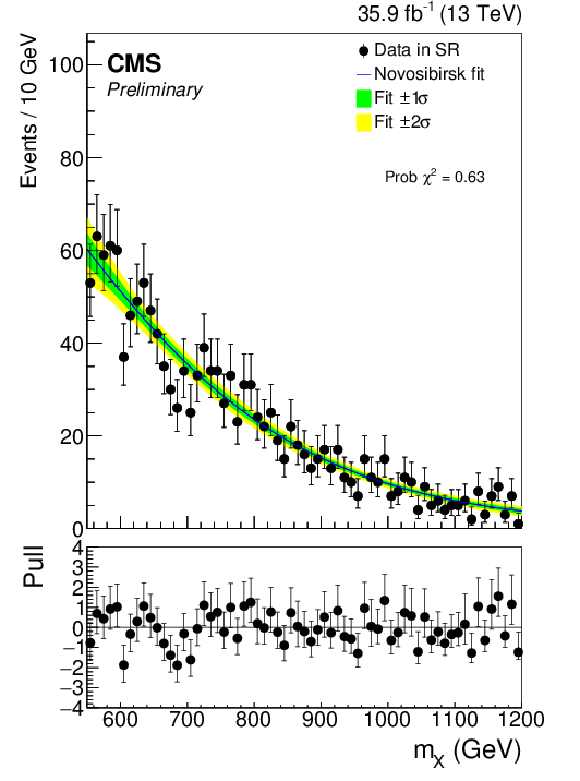
png pdf |
Figure 7:
The $m_X$ distribution of the QCD multijet component of the background in the Signal Region in data for the MMR. A fit to the background-only hypothesis, which consists of the QCD multijet shape is shown. The shaded regions correspond to a $\pm $1 and 2 $\sigma $ variation of this parametrized form. |

png pdf |
Figure 8:
The observed and expected upper limits on the cross section for a spin-2 resonance ${\mathrm {X}\to \mathrm {H}(\mathrm {b}\bar{\mathrm {b}})\mathrm {H}(\mathrm {b}\bar{\mathrm {b}})}$ at a 95% confidence level using data corresponding to an integrated luminosity of 35.9 fb$^{-1}$ at $\sqrt {s} = $ 13 TeV using the asymptotic CL$_S$ method. Theoretical cross section for the Bulk KK-Graviton, with $k/M_{Pl}= $ 0.5, $kl = $ 35, decaying to four b jets via Higgs bosons is overlaid. The transition between LMR and MMR is based on the expected sensitivity, resulting in the observed discontinuity. |

png pdf |
Figure 9:
The observed and expected upper limits on the cross section for a spin-0 resonance ${\mathrm {X}\to \mathrm {H}(\mathrm {b}\bar{\mathrm {b}})\mathrm {H}(\mathrm {b}\bar{\mathrm {b}})}$ at a 95% confidence level using data corresponding to an integrated luminosity of 35.9 fb$^{-1}$ at $\sqrt {s} = $ 13 TeV using the asymptotic CL$_S$ method. Theoretical cross section for the radion, with ${\lambda}bda =$ 3 TeV, $kl=$ 35, and no radion-Higgs boson mixing, decaying to four b jets via Higgs bosons is overlaid. The transition between LMR and MMR is based on the expected sensitivity, resulting in the observed discontinuity. |

png pdf |
Figure 10:
Observed and expected 95% confidence level upper limits on the production cross section times branching fraction for a spin-2 resonance decaying to HH, using data corresponding to an integrated luminosity of 35.9 fb$^{-1}$ at $\sqrt {s} = $ 13 TeV. The results from different searches investigating various combinations of Higgs boson decay modes are reported. |
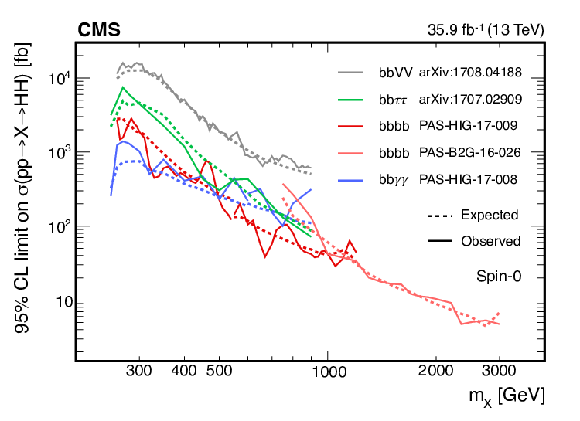
png pdf |
Figure 11:
Observed and expected 95% confidence level upper limits on the production cross section times branching fraction for a spin-0 resonance decaying to HH, using data corresponding to an integrated luminosity of 35.9 fb$^{-1}$ at $\sqrt {s} = $ 13 TeV. The results from different searches investigating various combinations of Higgs boson decay modes are reported. |
| Tables | |

png pdf |
Table 1:
Definitions of the regions we use in the "ABCD" method to test the functional form as described in text. |

png pdf |
Table 2:
Impact of systematic uncertainties on the signal efficiencies in the low-mass region (LMR) and the medium-mass region (MMR). |
| Summary |
| A search for a narrow-width resonance decaying into two Higgs bosons, each having a mass of 125 GeV and decaying into a $\mathrm{b\bar{b}}$ pair, is presented. The search is performed using proton-proton collision data corresponding to an integrated luminosity of 35.9 fb$^{\mathrm{-1}}$ at $\sqrt{s} = $ 13 TeV recorded by the CMS detector at the LHC. No evidence for a signal is observed and upper limits at a 95% confidence level on the production cross section for such spin-0 and spin-2 resonances, in the mass range from 260 to 1200 GeV, are set. Using these results, a radion with decay constant of 3 TeV and a bulk graviton with $k$ set to 0.5$M_{Pl}$ are excluded at a 95% confidence level in the mass range from 300 to 1100 GeV and 320 to 720 GeV respectively. |
| References | ||||
| 1 | CMS Collaboration | Observation of a new boson at a mass of 125 GeV with the CMS experiment at the LHC | Physics Letters B 716 (2012) | |
| 2 | ATLAS Collaboration | Observation of a new particle in the search for the Standard Model Higgs boson with the ATLAS detector at the LHC | Physics Letters B 716 (2012) | |
| 3 | ATLAS, CMS Collaboration | Combined Measurement of the Higgs Boson Mass in $ pp $ Collisions at $ \sqrt{s}= $ 7 and 8 TeV with the ATLAS and CMS Experiments | PRL 114 (2015) 191803 | 1503.07589 |
| 4 | L. Randall and R. Sundrum | A large mass hierarchy from a small extra dimension | PRL 83 (1999) 3370 | hep-ph/9905221 |
| 5 | W. D. Goldberger and M. B. Wise | Modulus stabilization with bulk fields | PRL 83 (1999) 4922 | hep-ph/9907447 |
| 6 | O. DeWolfe, D. Z. Freedman, S. S. Gubser, and A. Karch | Modeling the fifth dimension with scalars and gravity | PRD 62 (2000) 046008 | hep-th/9909134 |
| 7 | C. Csaki, M. Graesser, L. Randall, and J. Terning | Cosmology of brane models with radion stabilization | PRD 62 (2000) 045015 | hep-ph/9911406 |
| 8 | H. Davoudiasl, J. L. Hewett, and T. G. Rizzo | Phenomenology of the Randall-Sundrum Gauge Hierarchy Model | PRL 84 (2000) 2080 | hep-ph/9909255 |
| 9 | C. Csaki, M. L. Graesser, and G. D. Kribs | Radion dynamics and electroweak physics | PRD 63 (2001) 065002 | hep-th/0008151 |
| 10 | K. Agashe, H. Davoudiasl, G. Perez, and A. Soni | Warped Gravitons at the LHC and Beyond | PRD 76 (2007) 036006 | hep-ph/0701186 |
| 11 | G. F. Giudice, R. Rattazzi, and J. D. Wells | Graviscalars from higher dimensional metrics and curvature Higgs mixing | NPB 595 (2001) 250 | hep-ph/0002178 |
| 12 | A. Oliveira | Gravity particles from Warped Extra Dimensions, a review. Part I - KK Graviton | Journal submission in preparation | 1404.0102 |
| 13 | CMS Collaboration | Search for resonant pair production of Higgs bosons decaying to two bottom quark-antiquark pairs in proton-proton collisions at 8 TeV | PLB749 (2015) 560--582 | CMS-HIG-14-013 1503.04114 |
| 14 | ATLAS Collaboration | Search for pair production of Higgs bosons in the $ b\bar{b}b\bar{b} $ final state using proton--proton collisions at $ \sqrt{s} = $ 13 TeV with the ATLAS detector | PRD94 (2016), no. 5, 052002 | 1606.04782 |
| 15 | ATLAS Collaboration | Search for Higgs boson pair production in the $ b\bar{b}b\bar{b} $ final state from pp collisions at $ \sqrt{s} = $ 8 TeVwith the ATLAS detector | EPJC75 (2015) 412 | 1506.00285 |
| 16 | CMS Collaboration | Search for Higgs boson pair production in events with two bottom quarks and two tau leptons in proton-proton collisions at sqrt(s) = 13 TeV | CMS-HIG-17-002 1707.02909 |
|
| 17 | CMS Collaboration | Search for two Higgs bosons in final states containing two photons and two bottom quarks in proton-proton collisions at 8 TeV | PRD94 (2016), no. 5, 052012 | CMS-HIG-13-032 1603.06896 |
| 18 | ATLAS Collaboration Collaboration | Search for higgs boson pair production in the $ {\gamma} {\gamma}b\overline{b} $ final state using $ pp $ collision data at $ \sqrt{s}=8\text{}\text{}\mathrm{TeV} $ from the atlas detector | PRL 114 (Feb, 2015) 081802 | |
| 19 | ATLAS Collaboration Collaboration | Searches for higgs boson pair production in the $ hh {\rightarrow}bb {\tau} {\tau} $, $ {\gamma} {\gamma}w{W}^{*} $, $ {\gamma} {\gamma}bb $, $ bbbb $ channels with the atlas detector | PRD 92 (Nov, 2015) 092004 | |
| 20 | CMS Collaboration | Search for resonant and nonresonant Higgs boson pair production in the bblnulnu final state in proton-proton collisions at sqrt(s) = 13 TeV | CMS-HIG-17-006 1708.04188 |
|
| 21 | CMS Collaboration | The CMS experiment at the CERN LHC | JINST 3 (2008) S08004 | CMS-00-001 |
| 22 | GEANT4 Collaboration | GEANT4 --- a simulation toolkit | NIMA 506 (2003) 250 | |
| 23 | M. Gouzevitch et al. | Scale-invariant resonance tagging in multijet events and new physics in higgs pair production | Journal of High Energy Physics 07 (2013) 148 | |
| 24 | J. Alwall et al. | The automated computation of tree-level and next-to-leading order differential cross sections, and their matching to parton shower simulations | JHEP 07 (2014) 079 | 1405.0301 |
| 25 | S. Carrazza, J. I. Latorre, J. Rojo, and G. Watt | A compression algorithm for the combination of PDF sets | EPJC 75 (2015) 474 | 1504.06469 |
| 26 | J. Butterworth et al. | PDF4LHC recommendations for LHC Run II | JPG 43 (2016) 023001 | 1510.03865 |
| 27 | S. Dulat et al. | The CT14 Global Analysis of Quantum Chromodynamics | PRD 93 (2015) 033006 | 1506.07443 |
| 28 | L. A. Harland-Lang, A. D. Martin, P. Motylinski, and R. S. Thorne | Parton distributions in the LHC era: MMHT 2014 PDFs | EPJC 75 (2015) 204 | 1412.3989 |
| 29 | NNPDF Collaboration | Parton distributions for the LHC Run II | JHEP 04 (2015) 040 | 1410.8849 |
| 30 | A. Buckley et al. | LHAPDF6: parton density access in the LHC precision era | EPJC 75 (2015) 132 | 1412.7420 |
| 31 | T. Sjostrand et al. | An Introduction to PYTHIA 8.2 | CPC 191 (2015) 159 | 1410.3012 |
| 32 | CMS Collaboration | Particle-flow reconstruction and global event description with the CMS detector | Submitted to JINST | CMS-PRF-14-001 1706.04965 |
| 33 | M. Cacciari, G. P. Salam and G. Soyez | The anti-$ k_t $ jet clustering algorithm | Journal of High Energy Physics 04 (2008) 063 | |
| 34 | M. Cacciari, G. P. Salam, and G. Soyez | FastJet User Manual | EPJC72 (2012) 1896 | 1111.6097 |
| 35 | M. Cacciari and G. P. Salam | Dispelling the $ N^{3} $ myth for the $ k_t $ jet-finder | PLB641 (2006) 57--61 | hep-ph/0512210 |
| 36 | CMS Collaboration | Determination of jet energy calibration and transverse momentum resolution in CMS | JINST 6 (2011) P11002 | CMS-JME-10-011 1107.4277 |
| 37 | CMS Collaboration | Heavy flavor identification at CMS with deep neural networks | CDS | |
| 38 | D. Guest et al. | Jet Flavor Classification in High-Energy Physics with Deep Neural Networks | PRD 94 (2016) 112002 | 1607.08633 |
| 39 | CMS Collaboration | Identification of b-quark jets with the CMS experiment | Journal of Instrumentation 8 (2013) P04013 | CMS-BTV-12-001 1211.4462 |
| 40 | CMS Collaboration | Identification of b quark jets at the CMS Experiment in the LHC Run 2 | CMS-PAS-BTV-15-001 | CMS-PAS-BTV-15-001 |
| 41 | CMS Collaboration | Search for a massive resonance decaying to a pair of Higgs bosons in the four b quark final state in proton-proton collisions at $ \sqrt{s}= $ 13 TeV | 1710.04960 | |
| 42 | CMS Collaboration | Search for the standard model Higgs boson produced in association with a W or a Z boson and decaying to bottom quarks | PRD89 (2014), no. 1, 012003 | CMS-HIG-13-012 1310.3687 |
| 43 | CMS Collaboration | Search for the standard model Higgs boson produced through vector boson fusion and decaying to $ b \overline{b} $ | PRD92 (2015), no. 3, 032008 | CMS-HIG-14-004 1506.01010 |
| 44 | A. Hoecker et al. | TMVA: Toolkit for Multivariate Data Analysis | PoS ACAT (2007) 040 | physics/0703039 |
| 45 | Belle Collaboration | A detailed test of the CsI(Tl) calorimeter for BELLE with photon beams of energy between 20-MeV and 5.4-GeV | NIMA441 (2000) 401--426 | |
| 46 | CMS Collaboration | CMS Luminosity Measurement for the 2016 Data Taking Period | CMS-PAS-LUM-17-001 | CMS-PAS-LUM-17-001 |
| 47 | CMS Collaboration | Determination of jet energy calibration and transverse momentum resolution in cms | Journal of Instrumentation 6 (2011) | |
| 48 | A. L. Read | Presentation of search results: the cls technique | Journal of Physics G: Nuclear and Particle Physics 28 (2002) | |
| 49 | The ATLAS Collaboration, The CMS Collaboration, The LHC Higgs Combination Group Collaboration | Procedure for the LHC Higgs boson search combination in Summer 2011 | technical report, CERN, Geneva, Aug | |
| 50 | V. Barger and M. Ishida | Randall-Sundrum Reality at the LHC | PLB 709 (2012) | 1110.6452 |

|
Compact Muon Solenoid LHC, CERN |

|

|

|

|

|

|